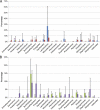Evidence of uncultivated bacteria in the adult female bladder
- PMID: 22278835
- PMCID: PMC3318548
- DOI: 10.1128/JCM.05852-11
Evidence of uncultivated bacteria in the adult female bladder
Abstract
Clinical urine specimens are usually considered to be sterile when they do not yield uropathogens using standard clinical cultivation procedures. Our aim was to test if the adult female bladder might contain bacteria that are not identified by these routine procedures. An additional aim was to identify and recommend the appropriate urine collection method for the study of bacterial communities in the female bladder. Consenting participants who were free of known urinary tract infection provided urine samples by voided, transurethral, and/or suprapubic collection methods. The presence of bacteria in these samples was assessed by bacterial culture, light microscopy, and 16S rRNA gene sequencing. Bacteria that are not or cannot be routinely cultivated (hereinafter called uncultivated bacteria) were common in voided urine, urine collected by transurethral catheter (TUC), and urine collected by suprapubic aspirate (SPA), regardless of whether the subjects had urinary symptoms. Voided urine samples contained mixtures of urinary and genital tract bacteria. Communities identified in parallel urine samples collected by TUC and SPA were similar. Uncultivated bacteria are clearly present in the bladders of some women. It remains unclear if these bacteria are viable and/or if their presence is relevant to idiopathic urinary tract conditions.
Figures




References
Publication types
MeSH terms
Substances
Grants and funding
LinkOut - more resources
Full Text Sources
Other Literature Sources
Medical

